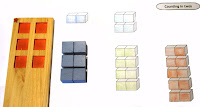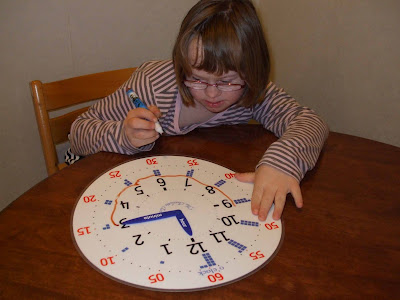In just 6 weeks Oliver has developed sufficient understanding about what a number represents so as to have his own 'beginners tools' to really participate in the learning where he uses these tools to learn new concepts। This approach also enables a student to reason for himself and to think about how his own knowledge can be drawn upon to explore something new.
The concrete equipment used to teach the 'tools' still has a part to play in moving forward, although the active facility becomes a passive facility. This is equally important to the student because h/she requires a quick means of referencing or 'triggering' familiar knowledge in order to facilitate a new concept. An example of this is given below...
Adding 1 and 2 to a number
First Oliver was asked to order the Pattern Boards for reference purposes only. On the display card I placed 2 cubes (known pattern). Next I hid this behind a screen where I added two more cubes. Then taking the screen away, I said "What did I do?" Oliver replied "There's two more, it's 4!" It did not matter whether I added 1, or 2 cubes, or took 1 or 2 cubes away he was able to state exactly what had happened.
Note:The early pattern board activities in the Stern programme where pupil's learn to recognise, then build their own patterns, followed by ordering from the smallest to the biggest, then from 1 to 10, make these later tasks meaningful! They can see exactly what is happening. The visual imagery of the boards is extremely powerful and supportive.
My next activity was to vbuild 10, Oliver told me how many in an instant. Behind the screen I took 2 away. He was just as quick to tell me waht I had done and to give me the new total (8). I continued to remove 2 cubes each time where he said (6), then (4), then (2) and earned ***** stars!
Increased expressive language
Note:I have mentioned in past posts how Oliver was reticient to verbalise or ask questions, however, his increased confidence and the 'knowing' that he is learning, has made the difference. Today he showed some lovely spontaneous responses. The homework last week really helped to reinforce this emerging ability.
Counting in 2s
I could have introduced counting in 2's at an earlier point but to do so would have made it difficult for Oliver to grasp this concept. He would not have taken any meaning from a rote procedure. Instead, waiting until he has some understanding about quantity, as well as the support from the number structure he has internalised, this makes my task easier and Oliver's ability to comprehend. Rather than learn rote counting, which at best, would become a meaningless chant of number words. I have to help him make associations with what he knows and to understand why it is more efficient to count in 2s. A vital part of this is to continuously encourage a pupil's reasoning ability. Also my philospohy - learned from my years of portage work with my own daughter - is to see what the student already has in place in which to build upon..
We have the 2-blocks (quantity known); we have the set of structured pattern boards (quantity and order known); we have Oliver's ability to recognise patterns; we have his ability to colour and is something Oliver enjoys. There are sufficient skills here for me to top layer a new idea.
On the Display Card, using the same colours as the 2-block, I placed two cubes (associations). When Oliver named the quantity, I gave him a 2-block. We placed it horizontally next to the card. I then added two more cubes. Oliver told me it was now 4. I gave him another 2-block which was then placed underneath the first keeping a small gap for clearer identification. We touched and counted 2, 4. The 4-board was pulled down to also reinforce the quantity. These steps were continued up to 10, giving us 10 sngle cubes on the card, five lots of 2-blocks and the 10-pattern board.
 More reinforcement of the concept Using a worksheet with images of 2-blocks in qunatities of 2, 4, 6, 8, 10, I began to place a 2-block on top of the first image sayiing 2! Moving to the next two groups I covered each image with blocks and counted 2, 4, then 2, 4, 6,. At the end of each count we found the correct pattern board to verify the count. and the 2-blocks we bgan the count. I Oliver took the lead with the count for 8 and then 10. Finally Oliver coloured the groups of 2's in each pattern. Following this, taking away all of the prompts, I scattered a quantity of 2-blocks where were I touched and we counted 2, 4, 6, 8, 10.
More reinforcement of the concept Using a worksheet with images of 2-blocks in qunatities of 2, 4, 6, 8, 10, I began to place a 2-block on top of the first image sayiing 2! Moving to the next two groups I covered each image with blocks and counted 2, 4, then 2, 4, 6,. At the end of each count we found the correct pattern board to verify the count. and the 2-blocks we bgan the count. I Oliver took the lead with the count for 8 and then 10. Finally Oliver coloured the groups of 2's in each pattern. Following this, taking away all of the prompts, I scattered a quantity of 2-blocks where were I touched and we counted 2, 4, 6, 8, 10.Estimating within ten - moving away from the structure then bringing it back to find the answer
The pattern boards are still at the end of the table for reference purposes. Oliver glances at them on occasions showing that he is mentally checking his thinking. Also I will refer to them in a prompting way to enable Oliver to find the answer for himself. I scattered a quantity of counters whilst Oliver made three columns on the white board for recording. We were fortunate to have David Cudworth Education Officer at Ups and Downs South West visiting, and like all visitors they get to join in the games. Taking turns, to guess how many counters, amounts recorded by Oliver, I would then move the counters, two at a time, into a Stern pattern counting 2, 4, 6, 8. The complete pattern was instantly recognisable by Oliver. David pulled down the 8-board for verification. Oliver checked his recording for the winner and assigned points which were agreed on at the beginning of the game.

In a previous game of estimating once counters had been scattered Oliver was able to state the exact quantity at a glance without counting or need to arrange the structure (subitization)
Bringing in 'even'numbers
A further aspect of number that also fits with this learning is the concept of even numbers. My student has already had an introduction to odd/even numbers in lesson 4 so our next task was to remind Oliver of tghe two explicit clues used to identify an 'even' and an 'odd' number. He was then able to recognise all of the even pattern boards. The pattern boards were already on hand and sequenced to facilitate this task.
Time telling practice
With the working clock on the all opposite my student I incorporate reading practice throughout the session. Today, using a worksheet with written moments of digital time Oliver read the first correctly then placed the clock hands on the practice clock correctly and read the time again. He went through the sheet 8:05, 6:15, 2:35, 1:55 (sc), 7:20, 9:10 (sc) 4:40, 6:00, 9:55, 12:00. The 'precise' point reading and recognition is going well, so today I introduced the first of the two phrases to encourage reading anywhere around the clock. 'It's just gone' or It's almost'. When the minute hand is between two 5 minute points as with 20 and 25 pupil's are encouraged to read 'It's just gone say 6: 20.' Whilst some pupil's can cope with the choice element this provides there will be some that find this too much to think about. In this case introduce one phrase first.
 Number Bond work
Number Bond work I gave Oliver and David a 10-Box each and asked both to tip out their blocks. I also placed a 10-block horizontally in front of them. The next instruction was to find two blocks that make 10 and place them alongside the 10-block. Oliver quickly selected both 5s saying 5 plus 5 equals 10 and wrote this down in his column. Taking turns with David, both selected their block partners saying the number sentence, verifying by placing alongside the 10, then Oliver recorded his and David's facts.
Observations: Oliver found all ten pairs quickly. He was able to place them on the table top without the support of the box. He also found, named and placed the reverse facts, as with 2 + 8 and 8 + 2. Also, he picked up the 10 block and said that 10 and zero make 10 and zero and 10 make 10! A further activity also highlighted this emerging understanding and was such fun. Whilst I was on 'oven duty' so as to bake the baguette for oliver's snack/break, I gave both men an empty 10-box and asked them to shout out the numbers as they place all ten facts into the box. Oliver had certainly overcome his shyness to do this verbal task! My student has demonstrated his increasing understanding of the bonds for 10 from memory. next week we will look at playing memory games to help trtansfer this concrete understanding to numeral/abstract equivalents.
Handwriting practice
Handwriting sheets are still going home for writing practice.
This was a very exciting and satisfying session where new concepts have been introduced - with the added attraction of David whom Oliver adores !
Vikki Horner





















